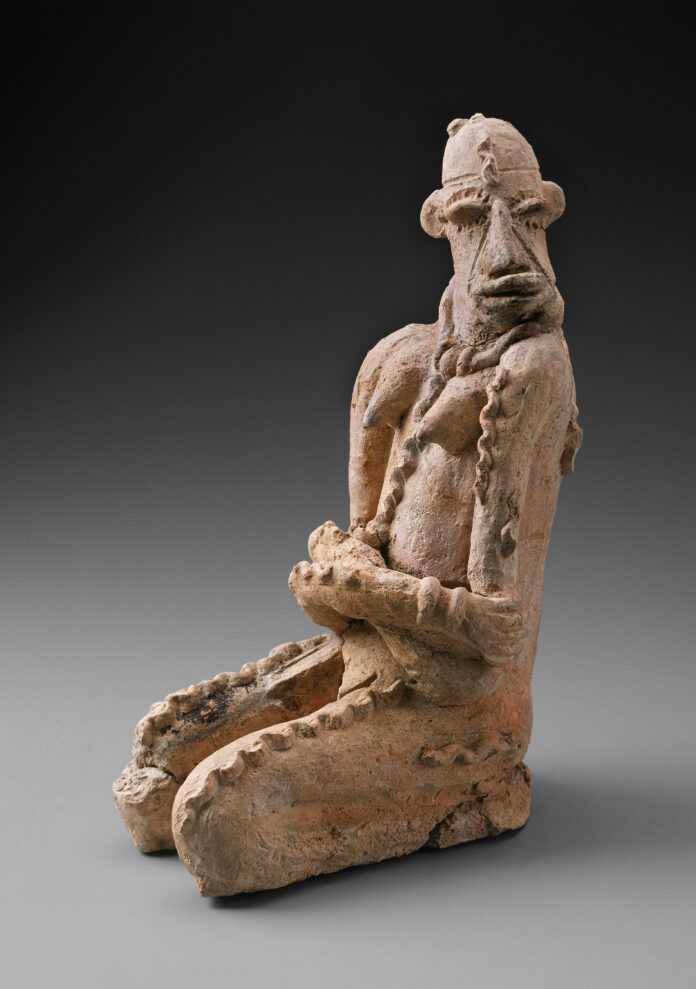
A pair of terra-cotta figures from Djenné, an ancient trading center in Mali, will soon be heading home from the Museum of Fine Arts, Boston. On Tuesday, the museum announced an agreement with the Mali government to return the antiquities, which are believed to have been illegally excavated sometime in 1980s.
“Restituting these two antiquities to their country of origin ensures not only that trafficked materials do not find a home in the Museum’s collection, but, equally important, that in the future the people of Mali will be able to enjoy these examples of their cultural heritage,” MFA director Matthew Teitelbaum said in a statement.
The two figures, dating from the 13th and 15th centuries, likely originated from Djenné-Djenno in southern Mali, the oldest known city in sub-Saharan Africa and a repository of UNESCO archeological sites. (Djenné-Djenno translates to “ancient Djenné,” in reference to the modern-day city Djenne in central Mali.) At the height of its power, the region was renowned for its sophisticated commerce and Islamic scholarship.
A 1977 American excavation of the Inner Niger Delta unearthed the elegant terra-cotta figurines depicting animals and humans: men on horseback, seated women, and human forms entwined by snakes. The most famous example, a huddled figure with its legs clasped to its chest, is owned by the Metropolitan Museum of Art.
Their existence was hardly a revelation, as similar terra-cotta figures discovered elsewhere in West Africa had been in demand by Western collectors for decades prior. But the Djenné-Djenno sculptures became a flashpoint of debates over the right to control and sell African antiquities due to their historical context. Rampant plundering threatened the fragile archeological sites, and trade in such artifacts violated UNESCO’s 1970 Convention on the Means of Prohibiting and Preventing the Illicit Import, Export and Transfer of Ownership of Cultural Property.
In the 1970s, Mali faced a famine, and smuggling art provided local workers with desperately needed income. International archaeologists urged an end to the operation, pleading with dealers, collectors, and museum administrators, but the digging continued. Today, most surviving Djenné-Djenno pieces are in circulation in the international art market, limiting opportunities for their scientific study. (The United States has since banned the import of unauthorized Malian antiquities.)
The MFA Boston was bequeathed the pair of figures—titled Figure of a Ewe and Kneeling Figure—from collector William Teel upon his death in 2012. Concerned that the sculptures were illicitly extracted from Mali, the museum contacted Mali’s Ministry of Culture the following year to obtain its approval before finalizing the acquisition. The ministry determined that the export of the works had not been approved and began negotiating their return.
“The excellent partnership with the MFA permitted the finalization of the administrative process leading to the restitution and the repatriation of two Djenné antiquities back to their original location,” Malian ambassador Issa Konfourou said in a statement. “A strong part of Mali’s cultural identity and heritage is captured by these kinds of artifacts that define daily lifestyles, engagement with others and singularities of whole tribes.”
In 2014, the MFA Boston reached an agreement with the National Commission of Museums and Monuments of Nigeria to return eight antiquities that were believed to have been illicit trafficked from the country. The group included two Nok terra-cotta figures, a terra-cotta Ife head, and an ekpu, or ancestral figure, that is now housed in the Oron Museum, located near the souther Nigerian city Calabar, as late as the 1970s. All eight objects were bequeathed by Teel, who acquired them in the 1990s from dealers in the United States and Europe.






















